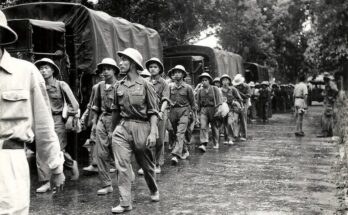Introduction: A Heroine Betrayed
Joan of Arc, the fearless warrior who led France to victory, met a tragic end not on the battlefield but in a courtroom. Her trial was more than just a legal proceeding; it was a political spectacle designed to erase her legacy. But what really happened during those harrowing months in 1431? Why was a national hero condemned as a heretic? This is the untold story of Joan of Arc’s trial, a tale of betrayal, manipulation, and ultimate martyrdom.
The Context: France at War and Joan’s Rise
The Hundred Years’ War: A Nation in Turmoil
The backdrop to Joan’s trial was the Hundred Years’ War (1337–1453), a brutal conflict between England and France over claims to the French throne. By the time Joan appeared on the scene, France was on the brink of collapse.
Joan’s Divine Mission
A teenage peasant girl from Domrémy, Joan claimed to have received visions from saints instructing her to support Charles VII and drive out the English. Her unshakable faith and military successes turned her into a national icon, but they also made her powerful enemies.
The Capture: How Joan Fell into Enemy Hands
The Betrayal at Compiègne
In May 1430, Joan was captured by the Burgundians, allies of the English. Instead of rescuing her, Charles VII distanced himself, leaving her fate in the hands of her enemies.
Sold to the English
The Burgundians sold Joan to the English for 10,000 livres. For the English, Joan was a dangerous symbol of French resistance who needed to be eliminated.
The Trial: A Farce in the Name of Justice
The Political Nature of the Trial
Although disguised as a religious inquiry, Joan’s trial was politically motivated. The English-controlled church sought to discredit her divine visions and thereby weaken Charles VII’s legitimacy.
The Role of Bishop Pierre Cauchon
Pierre Cauchon, the pro-English bishop of Beauvais, presided over the trial. His goal was clear: find Joan guilty at all costs. Neutral judges were excluded, and the trial broke multiple legal protocols.
The Charges: Twisting the Truth
Heresy and Witchcraft Accusations
Joan was accused of heresy, witchcraft, and cross-dressing (since she wore male armor). The latter charge was particularly absurd, as she had dressed as a man for protection among soldiers.
The Clerical Interrogations
Over 10 weeks, Joan was interrogated almost daily. The court attempted to trap her with trick questions, but her intelligence and wit often left them speechless.
The Evidence: A One-Sided Affair
Lack of Real Proof
Despite accusations, no solid evidence proved Joan had committed heresy. Even theologians at the University of Paris were divided on her case.
The Forcing of a Confession
Under immense pressure, Joan was tricked into signing a confession. When she later retracted it, she sealed her fate.
The Verdict: A Foregone Conclusion
The Sentence of Death
On May 30, 1431, Joan was declared a relapsed heretic and sentenced to death by burning.
The Execution at Rouen
Joan was burned at the stake in Rouen’s marketplace. Witnesses reported she faced death with remarkable courage, calling upon Jesus in her final moments.
The Aftermath: The Trial Revisited
The Posthumous Retrial
In 1456, Pope Callixtus III ordered a retrial. The court overturned the original verdict, declaring Joan innocent and a martyr.
Canonization: Joan Becomes a Saint
Centuries later, in 1920, Joan was canonized by the Catholic Church, cementing her legacy as a saint and national heroine.
Smart Sensors for Monitoring Plant Growth Stages in Real-Time
Conclusion: A Legacy That Endures
Joan of Arc’s trial was not just a miscarriage of justice it was an attempt to erase her from history. Yet, her story has endured, inspiring generations with her courage, faith, and determination. The flames that consumed her body could not destroy her legend.
FAQs
1. Why was Joan of Arc tried for heresy?
Joan was accused of heresy primarily for her claims of divine visions and for wearing male attire. However, the trial was politically motivated to discredit her and Charles VII.
2. Who was responsible for Joan’s execution?
The English and their allies, led by Bishop Pierre Cauchon, orchestrated her trial and execution.
3. Did Joan of Arc really confess to her crimes?
Under pressure, Joan briefly signed a confession, but she later retracted it, leading to her execution.
4. Was Joan’s trial fair?
No, the trial was heavily biased, violating multiple legal procedures. Many judges were English supporters, and Joan was denied proper defense.
5. How is Joan of Arc remembered today?
Joan is remembered as a national heroine of France, a saint in the Catholic Church, and a symbol of courage and resistance worldwide.


